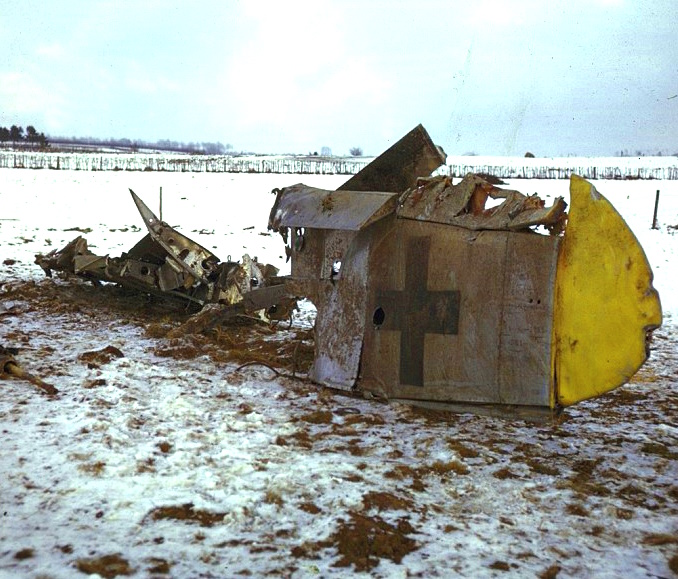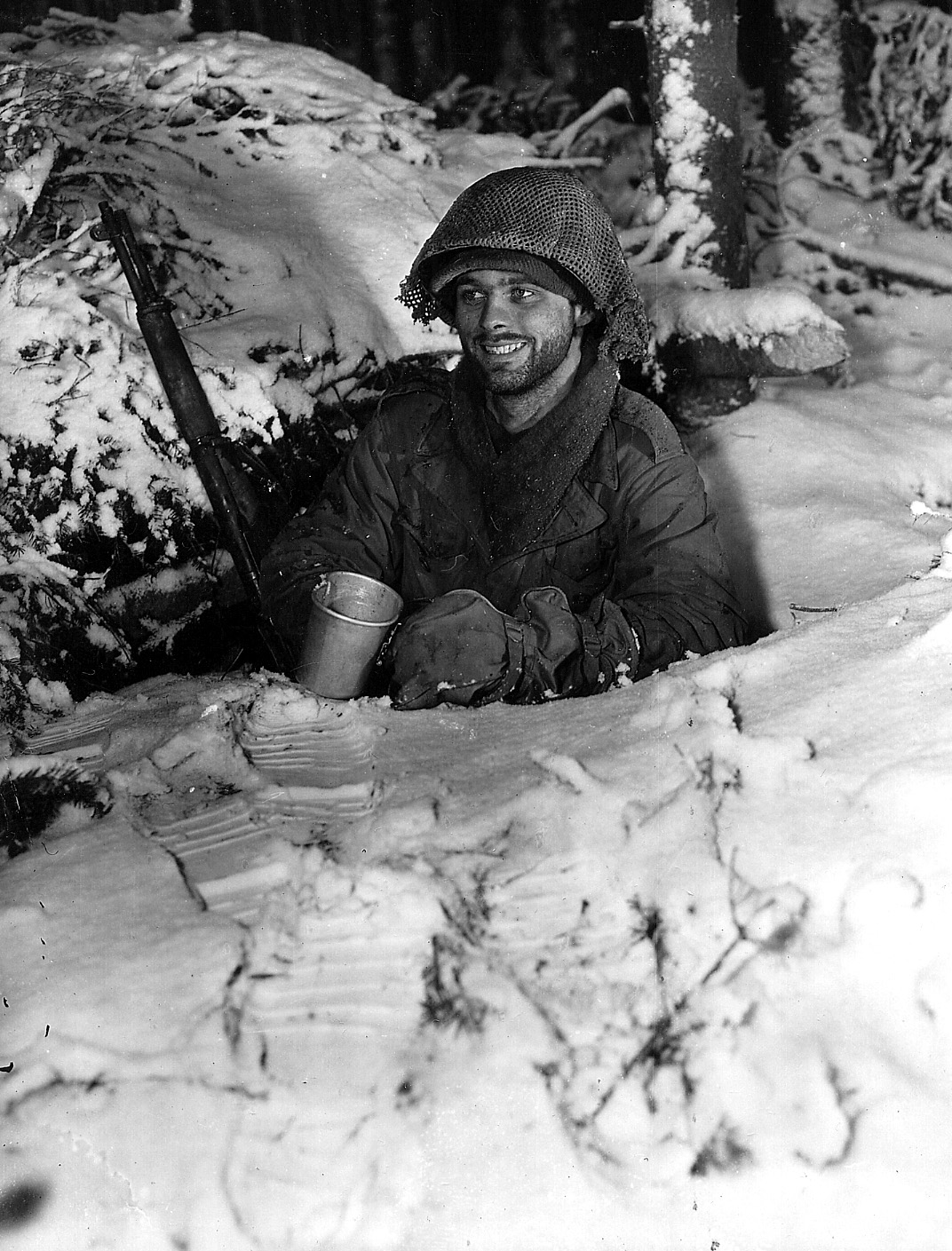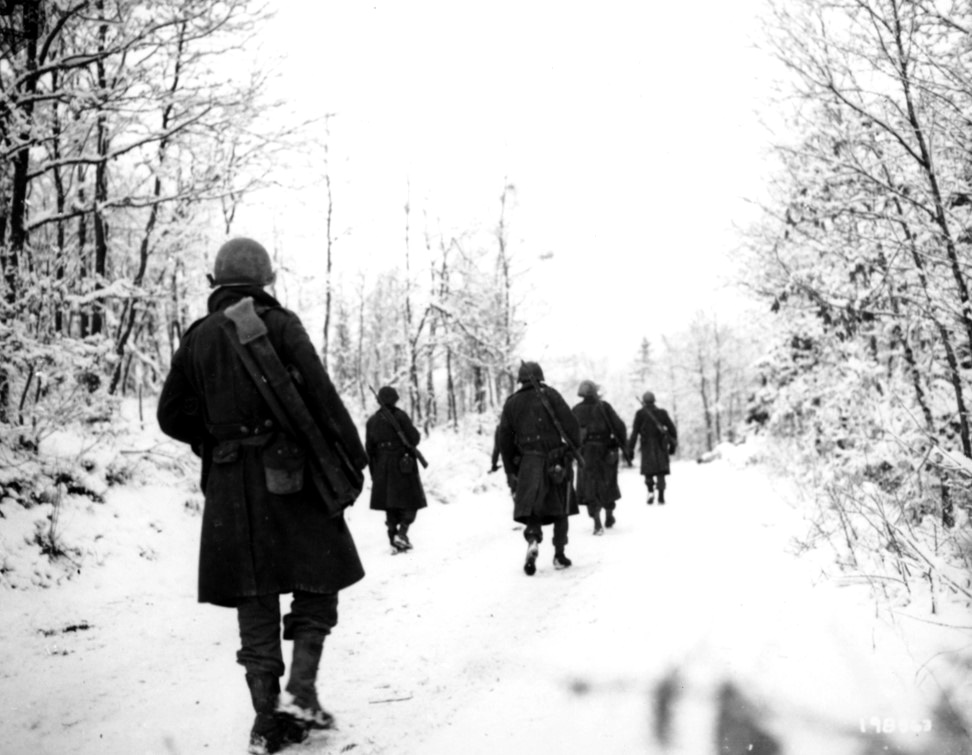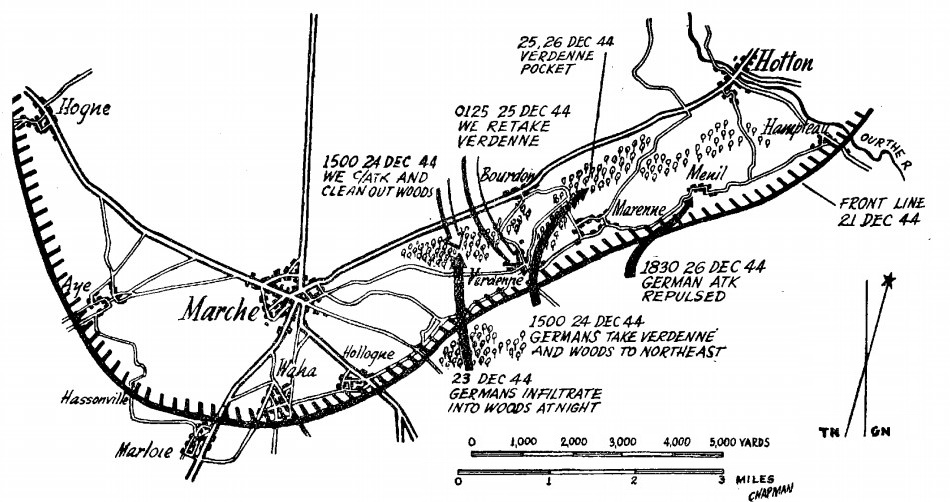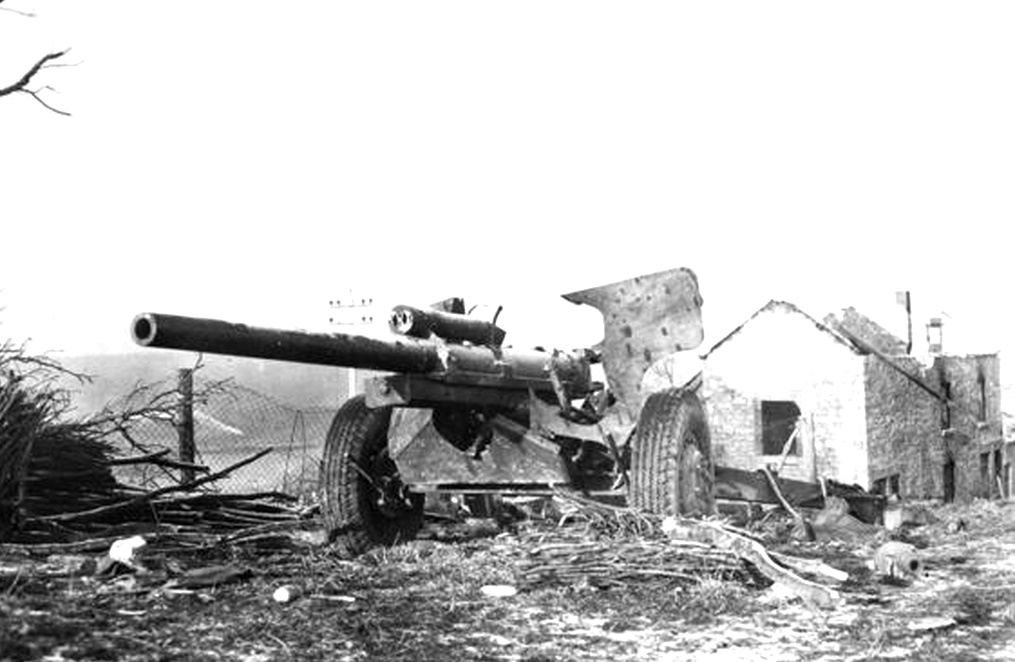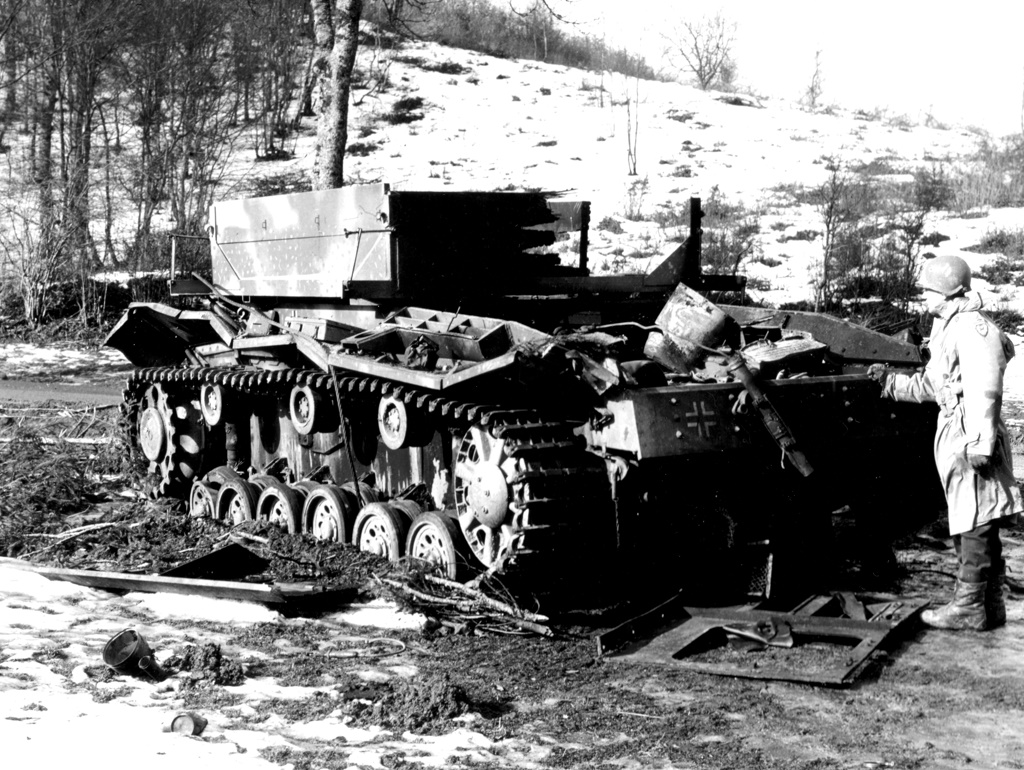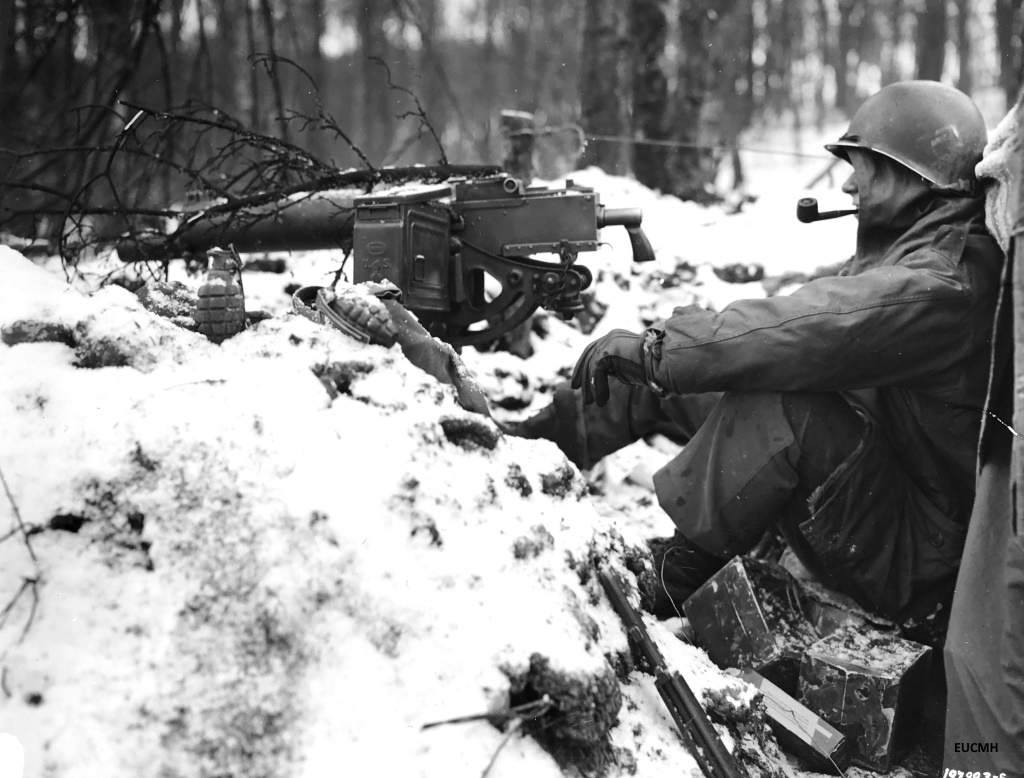At eight-thirty that night, December 23, King Co was ordered to return to Rochefort. There was no way of relaying the information to the 1st platoon which had gone off to Grupont. The rest tumbled into 2.5-ton trucks and started back. Outside Rochefort, they found it healthier to proceed on foot. The town was receiving a terrific shelling. In Rochefort, the action was pell-mell. The enemy had infiltrated in force and held most of the houses. King Co moved into a large hotel with Item Co. Throughout the night, German 88s, machine guns, and burp guns whistled and rattled all over town. We had two 57-MM AT guns and two heavy machine guns in front of the hotel. The next morning, December 24, a German tank came down the street and fired point-blank at the hotel, knocking out several jeeps. A tree burst of 88s landed in the middle of the crews of the AT guns. By nine-thirty, the battalion was ordered to leave Rochefort but only Mike Co and battalion HQs were able to entruck. Our men in the hotel decided to make a break for it. To cover their movement, they hurled smoke grenades into the middle of the street, blinding the German tank which was waiting for them. They started out the door in a dead run and headed for the railroad tracks to the north of Rochefort. A thousand yards down the tracks, they came to a wooded area. There, Lt Carpenter found he had two-thirds of King Co, half of Item Co, and a few men from every unit that had ever been in the vicinity.
Mike Co and battalion HQs reached Givet at one o’clock in the morning, on December 25. From Givet, the trucks went back and luckily found Lt Carpenter’s men on the road. The remainder of Item Co ran into elements of the 2-AD, north of Jemelle and came back directly to Marche. King Co’s 1st platoon stumbled across some engineers at Chanly who brought them in trucks to Givet. Love Co was relieved at Marloie the same day. Those who made the trip from Givet to Marche were constantly receiving reports that Marche had been taken by the enemy. As a result, they went as far north as St Trond in a big circle. They travelled about 125 miles in 36 hours instead of one-fifth the time and distance by a direct route. The whole battalion was back in Marche by noon, December 26. The efforts of the 1/333-IR were somewhat similar. On the morning of December 23, Baker Co was put out in Wellin, Charlie Co in Beauraing and Able Co remained in Wanlin. These towns were held until 11 o’clock that night when the battalion received orders to come back. When it received word that the Germans had taken Ciney, midway between Marche and Dinant, it too had to make an enormous circle to get back, going as far north as Namur and Obey. If the entire column had not turned around in place on a narrow road, it would have twice run into the 2.SS-Panzer which was coming through in force and had tangled with our 2-AD.
What did we accomplish? These efforts to block the enemy south of Marche served to delay his advance from Rochefort to the Meuse River and to give a valuable information of the enemy’s strength in this sector and the direction of his thrusts. It may also have served to deflect the enemy’s pressure from Marche itself until we were ready to meet it and to give the 2-AD, which was coming down below Marche, time to get set. But perhaps the most interesting thing about this action was the attitude behind it. It was conceivable that the division might have decided to sit tight around Marche, waiting for the Germans to come up. Apparently, by December 22, the enemy decided that Marche itself was too strongly held and preferred to go around Marche to the south. The Germans did get as far as four miles or so from Dinant and the possible threat of encirclement of Marche was temporarily acute. But, from almost the first moment, the whole conception of holding the Marche-Hotton area was aggressive. Our the battalion did not hold Rochefort but it did prevent the Germans from getting the idea that there was nothing to delay them in their way as early as December 22.
THE BATTLE OF VERDENNE

 By December 24, the fog had lifted for both sides. The 84-ID was dug in in front of and at both ends of the Marche-Hotton road. Its flanks had been filled in, the 2-AD on the right, the 3-AD on the left. The 2.SS-Panzer had twisted south of Marche, penetrating between Rochefort and Hargiinont. In a series of great tank battles around Celles, it was badly battered by our 2-AD. It
By December 24, the fog had lifted for both sides. The 84-ID was dug in in front of and at both ends of the Marche-Hotton road. Its flanks had been filled in, the 2-AD on the right, the 3-AD on the left. The 2.SS-Panzer had twisted south of Marche, penetrating between Rochefort and Hargiinont. In a series of great tank battles around Celles, it was badly battered by our 2-AD. It 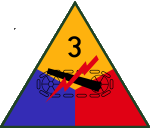
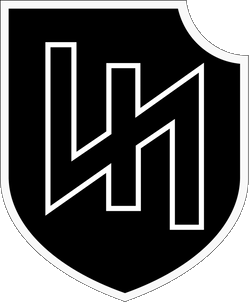 was now the turn of the 84-ID. The 116.Panzer-Division, one of the German’s first-rate outfits, tried to crack the very center of our line. Fortunately, it did not try until we had a line. In the center of our position was a triangle of villages, Verdenne, Marenne and Bourdon, the latter about a mile in back of the other two. Bourdon was the main objective because it cut the
was now the turn of the 84-ID. The 116.Panzer-Division, one of the German’s first-rate outfits, tried to crack the very center of our line. Fortunately, it did not try until we had a line. In the center of our position was a triangle of villages, Verdenne, Marenne and Bourdon, the latter about a mile in back of the other two. Bourdon was the main objective because it cut the  Marche-Hotton road in half. The village which bore the brunt of the enemy’s attack, however, was Verdenne because it was the door to Bourdon. The 3/334-IR was set up from a crossroads near Champlon to the village of Menil, a distance of about five miles, Item Co on the right, Love Co on the left, King Co in reserve and Mike Co in support.
Marche-Hotton road in half. The village which bore the brunt of the enemy’s attack, however, was Verdenne because it was the door to Bourdon. The 3/334-IR was set up from a crossroads near Champlon to the village of Menil, a distance of about five miles, Item Co on the right, Love Co on the left, King Co in reserve and Mike Co in support.
 On the night of December 23, an enemy force estimated at two recon companies succeeded in infiltrating behind Item’s Co’s position into a woods about half a mile west of Verdenne. The threat was obvious. At 1500, the next afternoon, December 24, the battle of Verdenne broke out. Strangely, we had chosen that very moment to launch our counterattack on the enemy pocket behind Item Co and the enemy had also chosen that moment to attack Verdenne. His plan was to hit Verdenne from the rear with the force in the woods and to hit it frontally at the same time with approximately the same strength. As a result of our counterattack on the woods, however, only half his plan came off. At 1500, we sent out King Co, 3/334-IR, and one platoon of Able Co, 771st Tank Battalion, followed by Able Co, 1/334-IR, to clean out the woods. The Germans had already reached the edge of the woods, intent on their own attack, when our four tanks opened fire on them while our infantry closed in. The German attack was completely broken up and the enemy tried vainly to flee. More than 100 prisoners were taken in the woods. But the other half of the German attack, the frontal assault on Verdenne, was temporarily more successful.
On the night of December 23, an enemy force estimated at two recon companies succeeded in infiltrating behind Item’s Co’s position into a woods about half a mile west of Verdenne. The threat was obvious. At 1500, the next afternoon, December 24, the battle of Verdenne broke out. Strangely, we had chosen that very moment to launch our counterattack on the enemy pocket behind Item Co and the enemy had also chosen that moment to attack Verdenne. His plan was to hit Verdenne from the rear with the force in the woods and to hit it frontally at the same time with approximately the same strength. As a result of our counterattack on the woods, however, only half his plan came off. At 1500, we sent out King Co, 3/334-IR, and one platoon of Able Co, 771st Tank Battalion, followed by Able Co, 1/334-IR, to clean out the woods. The Germans had already reached the edge of the woods, intent on their own attack, when our four tanks opened fire on them while our infantry closed in. The German attack was completely broken up and the enemy tried vainly to flee. More than 100 prisoners were taken in the woods. But the other half of the German attack, the frontal assault on Verdenne, was temporarily more successful.
An enemy force of 5 Mark V Panther tanks, 2 half-tracks, an armored car, and about 100 infantrymen drove into Verdenne and continued to move forward as far as a chateau about 200 yards north of the village. That night, the enemy was reinforcing his units in Verdenne and pushed a deep salient into the woods between Verdenne and Bourdon. Again we had to counterattack. At 0100 the next morning, December 25, King Co 3/334-IR, and Love Co, 3/333-IR, snapped back. Twenty-five minutes later, Verdenne was ours. It was Christmas morning. All that day, both companies were busy cleaning out the village and the chateau, gathering 9 officers and 296 enlisted men as prisoners. The Germans would infiltrate the village during the night and we had to mop it up for two more days. The total bag of prisoners for King Co alone was 472 before the action was over. After we retook Verdenne, however, the biggest job was still ahead. When we retook the village, the salient between Verdenne and Bourdon became a pocket of enemy resistance. This pocket was approximately 800 yards long and 300 yards wide in woods midway between Verdenne and Bourdon. In it were 5 enemy tanks and an estimated force of 2 infantry companies. All day, December 26, was spent on our part in efforts to eliminate the pocket and on the enemy’s part to break through and relieve it.

 First, we tried. At 0530, in the morning, December 26, Able and Baker Cos 1/333-IR, attacked the pocket but met strong tank lire and withdrew. Then they tried. At 0705 that same morning, the enemy sent over very heavy artillery fire, followed up by an infantry-tank task force. All our available artillery was immediately concentrated on this attack and broke it up. At 0800, they tried again, this time penetrating our lines approximately 100 yards and four more tanks broke through to join the five already in the pocket. By a 0945, however, our original lines were restored and we turned our full attention to the pocket. At 1015, the pocket was hit by units of the 334-IR, Doc Co, 87-MCB, and the 84-ID’s Artillery and four of the nine tanks were knocked out. But the slug ging was not over. At 2215 that night, still December 26, another desperate effort was made to wriggle out of the pocket but the Germans lost three more tanks without anything to show for them.
First, we tried. At 0530, in the morning, December 26, Able and Baker Cos 1/333-IR, attacked the pocket but met strong tank lire and withdrew. Then they tried. At 0705 that same morning, the enemy sent over very heavy artillery fire, followed up by an infantry-tank task force. All our available artillery was immediately concentrated on this attack and broke it up. At 0800, they tried again, this time penetrating our lines approximately 100 yards and four more tanks broke through to join the five already in the pocket. By a 0945, however, our original lines were restored and we turned our full attention to the pocket. At 1015, the pocket was hit by units of the 334-IR, Doc Co, 87-MCB, and the 84-ID’s Artillery and four of the nine tanks were knocked out. But the slug ging was not over. At 2215 that night, still December 26, another desperate effort was made to wriggle out of the pocket but the Germans lost three more tanks without anything to show for them.
At the end of December 26, our lines in the front of Verdenne were stabilized and we had punished the enemy’s troops and tanks in the pocket but we were not yet sure that it was completely clear. Only on the following night, December 27, was it possible to send a patrol in to investigate and it reported back that the pocket had vanished. Actually, this enemy pocket between Verdenne and Bourdon, the main threat to our position, was a matter of history by the night of December 26 and our front was quiet by the next night. There was another flurry on December 26 which helped to discourage the enemy. At about 1830 in the evening, when two enemy attempts at Verdenne had been repulsed, a strong enemy force, including 8 tanks, 10 half-tracks, 8 motorcycles, 1 US jeep, and about 80 infantrymen tried to break through at another point further north, this lime at the village of Menil, between Marenne and Hampteau. As this force came up the road from Marenne, it ran into a daisy chain of mines and had to leave the road. The trapped Germans drove right into the positions of Item Co and Mike Co, 3/333-IR. 2.36-inch Bazookas and rifle grenades opened up on the tanks. The enemy infantrymen tried to flee back to their own lines in the woods east of Menil. Three battalions of artillery were tired at the disorganized infantrymen while the vehicles were destroyed in the open field. By 0700, the action was over twenty-five enemy vehicles, including 6 tanks, were knocked out. The failure to break through the Marche-Hotton road was, in effect, Rundstedt’s last gasp. The German drive to the Meuse was finished. In the end, Rundstedt had driven some of his best divisions into a big bag in the Ardennes. At the tip of the bag was Marche. A week later, we were going to squeeze it and jam them back.
POST-MORTEM 1
Such was the skeleton of the defensive phase of the Battle of the Ardennes. It can be studied for a long time with a profit. Everyone who was in it again learned the old lesson that the way to hold is to hold. The strategic lesson may be less obvious. The Meuse and the Ardennes are tied together in a single, strategic knot. In 1914 and in 1940, the Meuse was considered the natural defensive position. No real preparations were made to fight in the Ardennes and, as a result, the Allies were slaughtered in these hills and woods in 1914, or they were not slaughtered in 1940 because they were practically not there. The Ardennes was considered such a formidable natural position that they were counted on to hold up the enemy virtually by themselves. This calculation was tragic both times. By 1940, military engineering had made such advances that it was fatuous.
May 1940 and December 1944 were two sides of the same coin. May 1940 showed that the Meuse could not be held if the Ardennes, was not held. This was the fatal mistake that Gamelin and Pétain who inspired the whole équipe of 1940, made. December 1944 showed that it was possible to hold the Ardennes, that in fact, its defensive possibilities were immense. A week later, we were going to learn the same lesson when the Germans were on the defensive. To hold the Ardennes, then, is to hold the Meuse and there may be no other way. At St Vith, at Bastogne, at Marche, this was demonstrated for the first time. We may be too close to these battles to see them fully but we are perhaps not too close to see what they mean.
If we did nothing else in the Ardennes, we destroyed a couple of myths. First, we destroyed the myth that the Meuse River and not the Ardennes was the natural defensive position. Then we had to destroy the myth that it was impossible to launch a large offensive in the Ardennes because it was impenetrable. The Germans began the second demonstration in 1940 but their feat, impressive as it was, was too one-sided to decide anything. They proved it was possible to go through the Ardennes but they did not prove it was possible to fight their way through. They met real opposition only twice and both times in clearings for a few hours. Above all, the Germans carefully chose the very best time of the year, in May, as if to emphasize that special conditions were necessary. In January 1945, we had to fight for practically every hill, wood, village, and road, in the very worst time of the year, in ice as slick as grease and snow waist-high, against skillful and stubborn opposition. The classic, offensive campaign of the Ardennes has been fought and we fought it.
